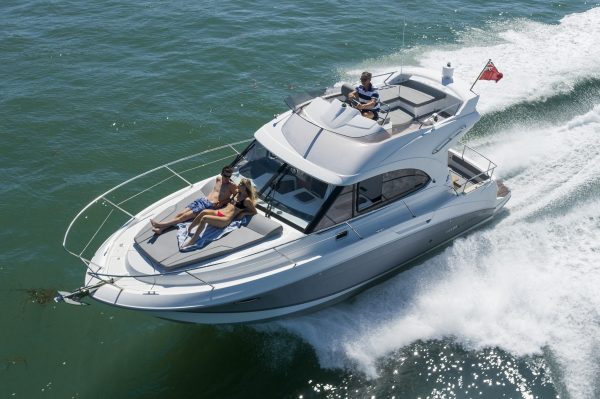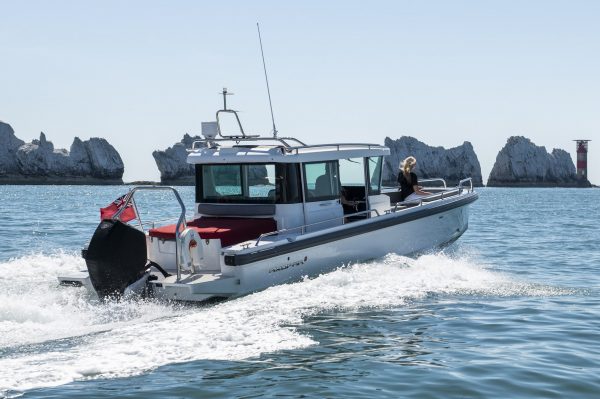The ultimate comparison guide to ownership, boat share and charter
When it comes to getting out on the water, whether you want to set sail or power up the engine, it can be hard to understand all the options and come up with something that suits your experience level, your ambitions, and the size of your wallet.
Here’s a handy primer that looks at different options at different stages, whether you’re looking to crew or heading out as a skipper.
Buying a boat
The traditional route to getting aboard and the dream for many people, despite the high capital outlay and expense of ongoing upkeep and mooring. Some variations to outright ownership have developed over the years, such as placing a boat in a charter scheme to offset costs or by taking a share in a syndicate to reduce costs. Both options sacrifice a degree of control and access in exchange for easing the financial and maintenance burdens.

OUTRIGHT OWNERSHIP
You buy the whole boat in much the same way that a car can be financed. You can buy it with cash or a personal loan, or if you wish to spread it over a longer term, can apply for a marine mortgage. As with a house mortgage, if you fail to make repayments on a marine mortgage the lender can repossess the boat and sell it to pay off the debt. You decide when you sail and where you sail, and you pay the mooring, maintenance and all other ongoing costs, such as insurance.
THE PROS
Use your boat at short notice or whenever you want it
Customize your boat to your specific needs and type of boating
No need to compromise on the type of boat that you want
Build familiarity with the same boat
A marina or sailing club may enable you to access a social network for races or other events
There may be a possibility to offset some of the costs by chartering the boat
THE CONS
Very high initial costs and long term commitment
Maintenance responsibilities and costs
Tied into using one type of boat for all occasions from the same location
No training or support
Desirable moorings may have a lengthy waiting list to join
Chartering has risks of increased wear and tear or damage and the income is variable.
PRIVATE SYNDICATES / JOINT OWNERSHIP
You buy a share of the boat and co-own it with others. You may get together with people you know and choose a boat to buy together, or you may take over someone’s share of an existing fractional-share boat. You share the maintenance and running costs based on your share and your use of the boat during the year will be proportionate to your ownership share and any agreement between you and the co-owners, which may cover things like how long each of you can take the boat for at any one time, how far ahead you must each agree bookings.
MANAGED SYNDICATES / JOINT OWNERSHIP
You buy a share of the boat and co-own it with others, but in this case you are buying from a company who will dictate which boats are available and the way that shares will be sold. Then they manage and maintain the boat and charge you a monthly fee. As with personally-managed fractional ownership boating, your use of the boat will be proportionate to your ownership share and how the company dictates that you and the co-owners can book the boat. This is the model used by Ancasta and Flexisail.
THE PROS
Reduced initial cost and on-going costs of ownership
Maintenance responsibilities are shared
Build familiarity with the same boat
A marina or sailing club may enable you to access a social network for races or other events
Customize your boat to your specific needs and type of boating (as long as it also suits the other owners and their budgets)
THE CONS
Long term commitment
Difficulty of finding or forming a suitable syndicate or scheme
Possible friction between owners over costs, maintenance responsibilities, and the condition or cleanliness at the end of each use
Tied into using one type of boat for all occasions
No training or support
Desirable mooring or clubs may have a waiting list to join
Increased wear and tear or damage
CHARTER LEASE-BACK
This is the Sunsail model. They choose the boat, with a fixed specification and model chosen to suit their charter fleet, and you buy it, then lease it back to them for a specific period of time, agreed at the outset. Finance options may be available via third parties and you receive a fixed income from the boat, together with an allocated number of weeks to sail the boat, while the company covers all operating costs. As part of a charter fleet, boats inevitably have a harder life and there is no control over who is sailing the boat. Alternative options include foregoing income in return for a reduced purchase option, paying upfront for just part of the boat. Once the contract ends, you have the choice of buying the boat outright.

Boat club membership
Boat and yacht clubs have existed since leisure sailing began, but typically these brought together boat owners to store, cruise or race their craft and, importantly, to socialise.
In recent years, a new style of club has emerged, taking ideas from property and car clubs, with a range of propositions. More of an owner experience than charter and offering short, custom booking slots, members gain a familiarity with the craft they use which solves one of the headaches of charter.
Some have taken what we call the ‘third way’ whereby a modest commitment – usually one year minimum – gives access to boats with flexible timeslots. Some will have multiple locations and a diverse fleet of boats; others will have one type of sail or motor craft and may have only one location. But the single most important differentiator is when clubs provide training, ongoing support and advice, plus the option to join a range of different boating events. The option to hone skills, experience more adventurous trips, race or simply socialise with other boaters and swap stories fits new and seasoned boater alike.
SAILING AND YACHTING CLUBS
A traditional route to getting on the water is to join a sailing club that has its own boats for use by members. Inevitably the amount of time available will be limited and unless it’s dinghy sailing, you’re unlikely to be able to take the boat out on your own and will be making up a crew with other members on pre-scheduled outings. Availability and costs vary depending on the club, but capital and maintenance will be covered by the club, generally leaving only your subscription and the daily costs incurred which will be shared among the crew.
SUBSCRIPTION-BASED ACCESS
This is the Pure Latitude model where users have low commitment access to high value assets. We choose a variety of boats, buy them, manage and maintain them, providing access to members through a points-based subscription where each boat or event uses up a fixed number of points. Availability is via a live booking system where all craft are open to booking, subject only to competence, and with limited constraints. For example, we ask that members use their points evenly over three seasons. Other subscription-based boat clubs operate on a similar principle but may restrict access or choice, such as through the range of boats available, or days available for sailing, depending upon membership package.
THE PROS
Low initial cost, and reasonable fixed on-going costs
A variety of boats may be available
A variety of locations may be available
No long term commitment – typically an annual agreement and monthly fixed costs
No maintenance responsibilities at all.
Excellent ability to change boat type and locations as necessary (with some clubs)
Good availability
Social network with other members for joint events
Strong training and support network available
THE CONS
Limited ability to customise boat to specific requirements or to personalise it
Boating times require a little more planning
Maximum booking duration (8 days) preclude extended cruising trips

Chartering a boat
Charter is the obvious option for those who wish to sail occasionally, as it avoids the capital outlay and ongoing cost of maintenance of ownership, while offering unrestricted choice of boat and location for each booking, whether you choose bareboat, skippered or flotilla. It is more of a holiday experience than an owner experience, which suits some, but a downside is not being able to get to know the boat beforehand. Generally there is little opportunity for social interaction with others or to incorporate any training, unless you join a flotilla.
The yacht charter market was traditionally made up of the charter companies, which own their own fleets of boats, and charter agents and brokers who simply manage the commercial usage of owners’ boats. More recently, internet platforms have evolved which use technology to bring together the individual charter agents in one place, and now we see the rise of the peer-to-peer platforms, which remove the yacht broker and bring together boat owners directly with users.
TRADITIONAL BOAT CHARTER BROKERS
This is most likely to be via a technological platform where you find all the brokers and their boats in one place. The advantages are the relative ease of access to the global market and clearer pricing which comes through competition and ease of comparison on these portals. A downside is rigid booking slots, which tend to be for a weekend or week, and the need to book well in advance to secure the slot you want.
TRADITIONAL BOAT CHARTER COMPANIES
This is how The Moorings, Sunsail and other operators such as Dream Yacht Charter get you on board, whether in the UK or overseas. Most of the companies will offer a choice of bareboat or skippered and some allow you to take just a cabin onboard a yacht shared with others. Many have flotilla sailing, with a group of boats following a course set by a guide who keeps track of those in the flotilla from the lead yacht. The need to book ahead, with slots fixed around weekends or full weeks is similar to broker charter.
P2P OR PEER-TO-PEER YACHT CHARTER
A technological platform acts as the intermediary to bring individual owners together with potential renters in a charter-style arrangement, whether bareboat or skippered, with the platform arranging the skipper as part of the service. Benefits are no capital or maintenance costs related to ownership, flexibility of booking – with the option of occasional renting – and the full range of craft to choose from, but as with other charter options, the unit cost per day remains generally higher than other options. To date, many of these P2P platforms are unproven and poorly regulated, and consequently carry risks for both the boat owner – through competence and damage issues – and for the boat user in terms of safety compliance, reliability and support.
THE PROS
No capital cost and relatively low costs of use
No commitment
No maintenance responsibilities at all
Ability to change boat type and locations
THE CONS
Very limited boat options available (e.g. virtually no ability to charter motor cruisers)
Availability variable (can be especially limited for some periods or particular events)
No social network
Cannot build familiarity with the same boat or customise it to your needs
Limited training or support network to ensure you have the appropriate skills
Variable maintenance and cleanliness standards
Charter boats are typically subject to high wear and tear and damage